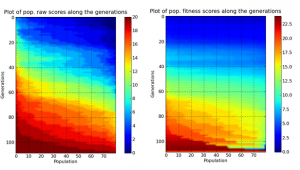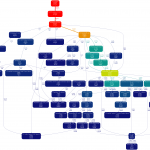This post is a report of an optimization test suite applied to Pyevolve GA Core.
I’m writing a paper about Pyevolve and I’ve done some tests on the GA quality of Pyevolve with must common optimization test functions: Schaffer, Rastringin, Sphere, Ackley and the absolute GA-hard Rosenbrock. Follows in the end of the post, the results of the trials, I’ve exported the latex formulae as images.
The only function that the GA had some trouble (it failed to find the global minima in 3 of 10 trials, the “fail” term means that it had not found an optimal solution for 5.000 generations) was the Rosenbrock’s function with 20 variables, also known as Rosenbrock’s banana function due the dinstinctive shape of the contour lines, here is the 3D plot with 2 variables.
As Wikipedia says,
This function is often used to test performance of optimization algorithms. The global minimum is inside a long, narrow, parabolic shaped flat valley. To find the valley is trivial, however to converge to the global minimum is difficult.
However, this behavior was not unexpected, since we can note the same on the research of [1], [2], [3] and [4], among other many papers.
I think this trial results brings more reliability to the framework, when the Pyevolve paper was published, I’ll post it here.
[1] Seredynski, Franciszek, et. al. (2003). “Function Optimization with Coevolutionary Algorithms”, in International Intelligent Information Processing and Web Mining Conference.
[2] Hiroyasu, Tomoyuki, et. al. (1999). “Distributed Genetic Algorithms with Randomized Migration Rate”, IEEE Proceedings of Systems, Man and Cybernetics Conference SMC’99, Vol. 1, pp. 689-694.
[3] Bouvry, Pascal, et. al. (1997). “Distributed evolutionary optimization in Manifold: the Rosenbrock’s function case study”, Duke University.
[4] Panait, Liviu (2002). “A comparison of two competitive fitness functions”, in GECCO 2002: Proceedings of the Genetic and Evolutionary Computation Conference.




